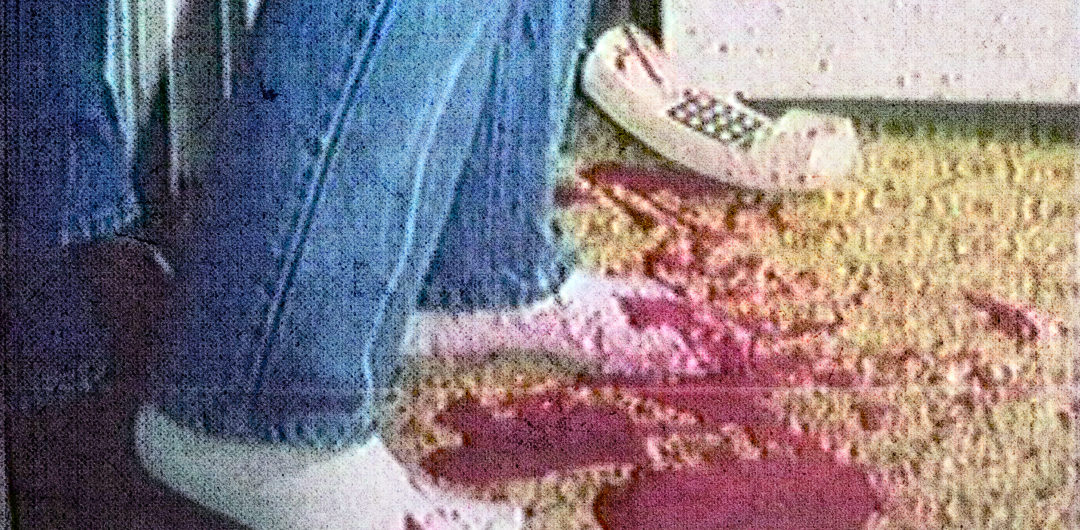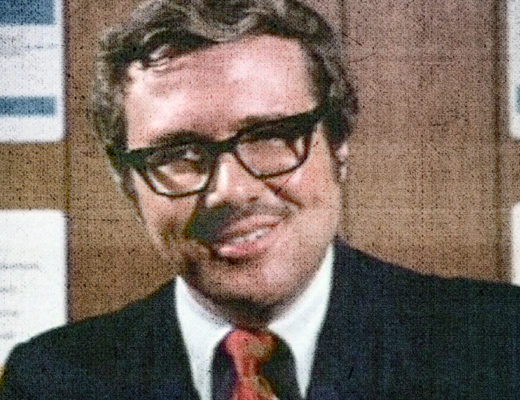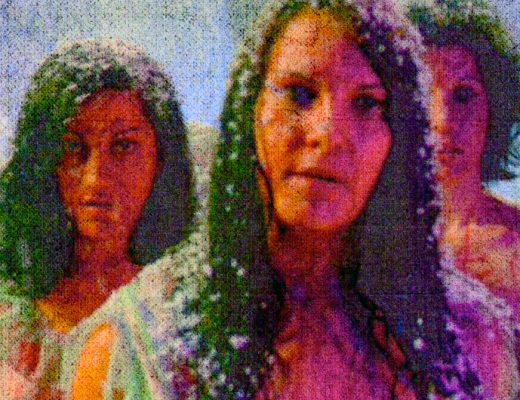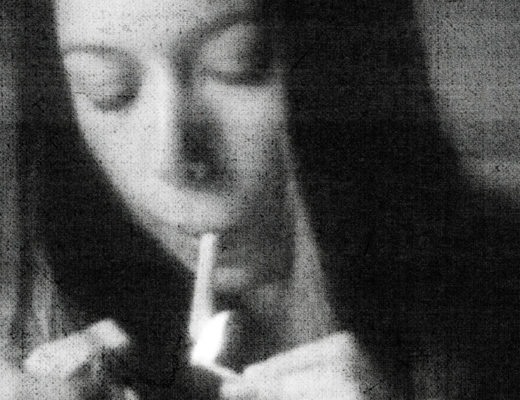The Abomination made all things desolate. As it turns out, desolation can be a pretty captivating place.
In 1986, writer-director Bret McCormick and partner-director Matt Devlen ensconced a Super 8 camera, hit the backyard, and got down to business. The results were The Abomination and Ozone! Attack Of The Redneck Mutants — two trash-gore films which were shot back-to-back in Texas, edited on video, then subsequently lost to the sands of video store time.
Over twenty years later, the sands have preserved. The Abomination and Ozone! are benchmark examples of determination, creativity, and incessant bedlam in 1980s American trash filmmaking. They’re the final gasp in a bloodline originated by such surreal epics as The Wizard Of Gore, Death Bed: The Bed That Eats, and Long Island Cannibal Massacre. Yet, this duo remains clouded in deep obscurity, rising ever higher amongst the ranks of VHS casualties with each passing year. Information has been scarce, while reasoning has remained ambiguous. Until now.
Bleeding Skull: In what context of your life were The Abomination and Ozone! created? Where in Texas were they shot?
Bret McCormick: I had graduated from film school, written a few screenplays, produced and directed my share of Tabloid! (Bret’s spoof-comedy debut — B.S.). I had a wife (Blue Thompson) and three sons. I was definitely flying on a wing and a prayer. It was the best of times and the worst of times.
We shot in Poolville which is out in the country west of Fort Worth on the way toward Jacksboro.
BS: What was the impetus behind the decision to shoot back-to-back? How did it all play out?
BM: We just had a tiny amount of money and we didn’t want to go to work for anyone else. We figured our odds of making a return were better on two films than one.
BS: Your partner, Max Devlen, directed Ozone!, while you took the reigns on The Abomination. What was your role (or roles) in the production of each film?
BM: Since both films were shot back to back, it was very much like shooting a single film. The Abomination was my baby, in that I had ultimate creative responsibility and Matt was creatively in charge of Ozone!. I ran camera on both films for the most part. But this really was like a backyard production in that we were both doing a little bit of everything. Whatever needed to be done at the moment, we did it. Matt had a lot of fun experimenting with the make-up as I recall. And he would round up tongues, eyeballs and all sorts of viscera from a local slaughterhouse.
BS: The Abomination has a reckless, offhand personality. Did the film adhere to an original script, or were you relying more on a spirit of urgency while shooting?
BM: Because I felt this need to just sort of improv the film, we worked from a hastily written 20 page outline. When Jude, (the lady who plays Cody’s mother) saw the script she was flabbergasted. “How long do you think this movie will be?” she asked me. When I told her it would be 90 minutes, she snorted derisively. I had heard all the stories about how Roger Corman, H.G. Lewis and others had put together schlock classics in a few days time and I was sort of reaching for that type of experience. These films were done on really low budgets and though everybody was paid “something”, nobody was paid much, so time was of the essence. You can only expect people who are basically working for free to show up so many times.
We had produced Tabloid! and spent a really long time in post production. All our money was running out. We had jumped off into filmmaking careers and didn’t want to have to go find a job. We weren’t making big deals with “Tabloid!” which had cost us $112,000. We realized that we had about the same odds of making money off a couple of cheap gore flicks as we did of making money off Tabloid! So we put our heads together, did some Super 8 film to video transfers to see what it would look like. We sort of liked the grainy, low definition look. Most of the H.G. Lewis films that were out on video at that time were poor transfers from poor, beat up old prints, so we felt like the Super 8 gave us a look that fit in with the ultra low budget genre. Later, I saw some of Lewis’s stuff on the big screen — new prints from the original elements and the colors were beautiful, definition really crisp. I don’t think anyone from the video era ever saw them that way. No one had seen them that way since their original releases in the X-rated theaters of the 60s. Even Tobe Hooper had deliberately “blued up” the images on The Texas Chainsaw Massacre, giving it a faded, old, semi-documentary look. Hooper saw the artistic value of deliberately degrading the image. Now, it’s practically a cliché. People with huge budgets make their movies look like Tobe Hooper’s little 16mm reversal film. Anyway, long story short, we decided we could do two feature length gore flicks for a little under $20,000. At that rate, we felt certain we could make our money back.
The first films I made were Super 8 movies my friends and I would throw together over a weekend when we were in middle school. Making these two films was like going back to those days. Matt and I were having a blast, just sort of wandering around the countryside shooting whatever nonsense popped into our noggins. There was a sense of freedom that I’ve never experienced on any other production.
I’ve done a lot of pictures down and dirty, but never had so much fun doing it as I did that autumn of 1986. Before production we talked Shiner Brewery into a product placement deal, so we had a small mountain of beer to drink, which probably contributed to the fun at the time.
BS: There’s a healthy amount of Biblical jabbing in the film, which is a noticable distinction in the realm of obscure 80s trash-gore. Was there much behind this, or was it merely an exploitative device?
BM: I was first exposed to religion in a little fundamental Baptist church in Fort Worth, TX. I went pretty much every Sunday until the age of twelve. There is a great deal of fear in those fundamental Christian sermons and a lot of that imagery stuck with me. I remembered reading the passage about the “abomination which makes all things desolate.” I didn’t know what The Abomination was and nobody could tell me what it was. It just seemed like a good jumping off point. I definitely had a healthy disregard for bogus televangelists, so I thought I’d use Brother Fogg to provide a little humor.
Probably another factor that contributed to this choice was the biblical references that had turned up in films like The Exorcist and The Omen. I remembered the impact those films had on me when I first saw them. Also, there was the well-established tradition of Science Fiction writers who would often use biblical references in their titles.
Too, I had read a lot of H.P. Lovecraft when I was a kid. Lovecraft’s stuff seemed to seep up through the filter of a religious perspective, but from a time before the deities of modern man held sway. The Abomination was my attempt to fuse H.P. Lovecraft with H.G. Lewis in a way that might be acceptable to 1980s viewers. If I could have figured out a way to do it on the budget, I would’ve had The Abomination grow so large it just burst out of the little farmhouse ala The Dunwich Horror.
On a personal note, I do not have an axe to grind against religion. I think it serves a purpose. I have a really deep respect for the teachings of Christ, as well as the teachings of Buddha. My personal belief system, or at least the direction I lean in is more like what you read in the books by Zechariah Sitchin. I would not at all be surprised to learn that the teacher from Galilee was a human-extra-terrestrial hybrid.
BS: One of The Abomination‘s most striking mood enhancers is the use of tape-manipulated voices, gruff synthesizers, and random library cues. Who was responsible for the collage approach to the soundtrack? How was it recorded?
BM: All of the post production audio was done by building up layers on the two audio tracks of the 3/4 video editing system we worked with. Matt had a neighbor who was a window washer but agreed to score a couple of pieces for the film. These are the gruff synthesizers you refer to. We owned a license free library of music that we made liberal use of. In that license free collection was a cut by Ennio Morricone called “The Strange Old Man”, its kind of a kooky percussion piece. I love Morricone, so I used that cut a few times. God! Who would’ve imagined a $10,000 movie with music by Ennio Morricone?
I always admired the technique of random repetitive phrases. Notably, I’d heard it in a version of John Lennon’s Revolution #9 (“number 9, number 9, number 9”) and I’d heard it in a trailer for the Paul Newman film The Mackintosh Man (“who are you?, who are you?, who are you?”) I remembered that I had really liked the impact this simple trick had carried. Since I didn’t have any money or fancy equipment, I did what I could to liven up the soundtrack.
BS: The make-up effects in both films are unbelievably crazed. The Abomination creature itself is quite impressive. It feels like a charming demo version of The Deadly Spawn. Given the film’s no-budget origins, how did you pull it off? What was it made of?
BM: I’m glad you liked the creature. I had a lot of fun building it. For the longest time I had a couple of images recurring in my head. I’d be outside mowing the lawn, or whatever and I kept “seeing” these two images and I had this strong compulsion to commit them to film. One was a vagina with teeth in it. The other was a bloody hand bursting out of a man’s chest. I think a real vagina with teeth in it would’ve been a little hard to deal with on many levels. Remember we were counting on foreign distribution to make our money back, and there are a lot of countries with strong censorship. And instead of a hand, which wouldn’t have made as much sense in this story, I settled for the toothy tentacle thing that bursts out of Cody.
I’d read FAMOUS MONSTERS OF FILMLAND for years during my childhood. I’d been exposed to their amateur make up contests and their how-to articles, so I had a passing familiarity with latex and fake blood. What I lacked in skill I made up for with enthusiasm.
The big creature in the cupboard was a hinged jaw made of plywood with a bunch of balsa wood teeth glued to it. Then with sheets of foam rubber, cotton balls and paper towels soaked in liquid latex I sort of built up the surface of the beast. We used tons of McCormick’s red food coloring.
BS: Was the same creative team responsible for the gore in both films?
BM: Yeah. Me, Matt and whoever was willing to get their hands dirty.
BS: Ozone!‘s mad-beast-in-a-hole is a low budget masterstroke; unexplained and surprisingly frightening. What was that thing?
BM: That was a hand puppet I made out of paper mache, masking tape, latex, foam rubber and a rabbit pelt. It was supposed to be a mutated coyote. It was pretty silly, but I’m very pleased that you liked it. We had nothing for the eyes, so one morning on the way to the shoot we just pulled into a taxidermy shop and begged the guy to give us some free glass eyes. I think they were supposed to be eyes used for an owl or other large bird.
BS: Sticking with Ozone!, the film utilizes a quirky set of characters. The redneck comedians, a hopeful country singer, the strange old lady — who were these people and how were they found?
BM: The film was shot in the community of Poolville, Texas and a lot of the extras were locals who just wanted to be in the movie. The “talent show” was shot in the local general store and featured some of the people from the town. Matt definitely had a particular style of script construction. You can see it in Ozone! and you can see it in “Killer Vacuum Destroys Town” in Tabloid!. I’ve often suspected that Matt was involved in the production of Eight Legged Freaks because the screenplay has his style written all over it.
BS: Whose cars and houses were destroyed during filming?
BM: My step dad had a good friend named Curtis Moore who was in the flooring business. Curtis owned the ranch where we did most of the filming. There were two houses on the property that he pretty much told us we could do whatever we wanted to. So we did.
The cars we bought from a guy named Leroy Kirby who operated an auto wrecking yard out there. We’d pay like $200.00 for a car with the understanding that he got it back when we were finished.
BS: What kind of equipment were you using to shoot and edit?
BM: We used a Braun Super 8 camera that we bought from some company in Massachusetts that specialized in Super 8 equipment. But, they were into producing things for PBS and the like, so when they found out what we were up to, they pretty much lost all respect for us. In other words, they didn’t want their name mentioned in any of our promo stuff.
We transferred the Super 8 footage to 3/4 video and edited on a local off line system. It took forever and my family was thinking I had gone nuts.
BS: So how did your family react to the films when all was said and done?
BM: Well, my family knew me very well. They knew I had obsessed over cheap, bad, gorey and exploitative movies since my early teens. They were not at all surprised by the content. When the first (bad) review of Ozone! came out I was reading it out loud and laughing…I was at my mother’s house and she looked up from whatever she was doing and said in a somber tone, “You know, that’s what people will remember about you.”
When I say they thought I was going nuts, I meant that I was spending an inordinate amount of time putting together a project that everyone thought had ZERO chance of making any money. Bills were piling up, etc. But, I was determined to get the films finished and out there. They couldn’t understand why I wouldn’t just drop the whole thing and go get a “real job”.
BS: Could you share a few details surrounding The Abomination‘s VHS release with Donna Michelle Productions?
BM: I know absolutely nothing about how that deal came about. By the time that happened Matt and I had dissolved our partnership. In settling up I took the rights to Tabloid! and he took the rights to the two gore flicks. I was not involved in any of the deals made to distribute the two films and I haven’t spoken with Matt for over 20 years.
BS: Give us the scoop on Muther Video, the company which initially released both films. Was this your own home video label? Who was that woman in the glorious/terrifying promo clips?
BM: The “Mutha” of Mutha Video was Matt’s mom, Barbara Davis. She played Wanita Lipscomb, the lady who sings at the talent show before getting her scalp ripped off. I think she’s still active in acting/modeling because I saw her face on a promo for the IBC bank recently.
Yeah, after we split, I think Matt decided he might as well start his own video label. We had been janked around by so many video distributors, I think he felt he had nothing to lose. The idea of having a sort of MC that breaks in once in a while came from the popular Elvira, Mistress of The Dark.
BS: Over two decades later, how do you feel about The Abomination and Ozone!, and further, how do they fit in amongst your later, more “professional” work?
BM: There was a time when I obsessed over low budget trash movies. I wanted to see them all. Why? Who knows. You tell me. From your piece on The Abomination, I know you can relate. I guess it was a phase. It just faded away. I pretty much don’t see them anymore unless my sons Joseph and Jeremiah are visiting and they rent one. I used to be crazy about motorcycles, too. But I haven’t ridden one for many years. Life’s short and we move on to other interests.
Obviously, The Abomination and Ozone took form out of that mass of mental imagery I acquired during that time. Had I been able to get distribution for horror films I probably would’ve done many more of them, because I thought they were fun. But most of the distributors that would return my phone calls were only interested in low budget shoot-em-ups.
Like my film Armed For Action (also shot in Poolville). It’s not a very good movie, but we shot it in 7 days and it contains some elements that exceed the limitations of the budget. It’s got lots of fire power, a great soundtrack by Ron DiUlio and a fun performance by Joe Estevez. Not to mention the sexy Barri Murphy.
Of my movies I think I like Rumble In The Streets best. (But, I don’t even like that one very much).
When I finished The Abomination I recognized it for what it was, but as Blue put it, “The Abomination is exactly the kind of movie you (me) like to stumble across in an out of the way video store.” And she was right. If I had not made it myself, but had just happened upon it, I would’ve loved it the same way I loved Basket Case.
I went to see a movie called Juno last week. I thought it was very funny and I was pleased to see the homage paid to Herschell Gordon Lewis and his Wizard Of Gore.
BS: I had the same reaction during Juno. Perhaps, one day, we’ll see The Abomination immortalized in a quaint hipster comedy starring Michael Cera. How would you feel about that?
BM: My crystal ball tells me that will happen shortly after I acquire the Sno-Cone concession in hell.
\BS: “You don’t have to emulate Truffaut Or Godard to be considered credible. You can emulate Herschell Gordon Lewis.” This quote, from your interview in John McCarty’s “The Sleaze Merchants”, initially sparked my interest in your films. With the presence of Wizard Of Gore in a mainstreamer such as Juno, these films have obviously come a long way. Do those thoughts still ring true for you today?
BM: What I meant was this…H.G. Lewis is memorable because he broke new ground and was willing to do things Hollywood would never dream of. The same is true of Truffaut & Godard. They worked with small budgets (like Lewis) and their films were introduced to American audiences by low end distributors who could not afford to acquire bigger films. Everything we see and do impacts our consciousness and changes who we are. Many big budget movies contain elements they would not otherwise have contained if the filmmakers responsible for them hadn’t had a (sometimes secret) liking for cheap cinema. I think the best example of someone legitimizing schlock elements would be Tim Burton.
BS: Will you ever return to the genre? “The Abomination II”, perhaps?
BM: My interests are almost completely in the metaphysical arena these days. If I produced another film it would probably be a documentary dealing with Visualizing World Peace, The Law of One or extraterrestrials.




